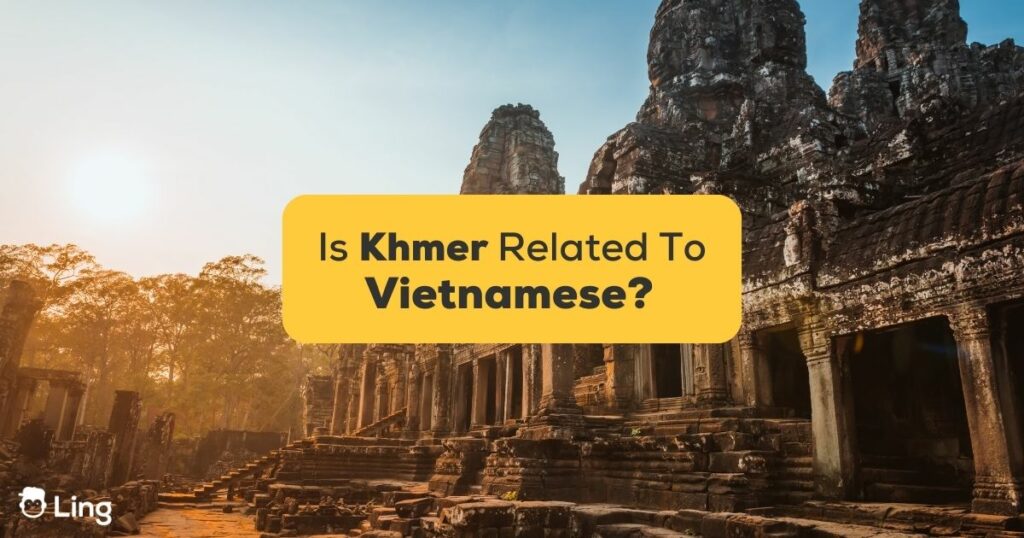Ever found yourself wondering if Khmer and Vietnamese are more than just geographical neighbors? In this post, we’re about to dive into the babel of Southeast Asian languages to answer the question, “Is Khmer Related To Vietnamese?” Buckle up! It’s time to take a wild ride through the riveting world of languages!
“But wait,” I hear you cry, “aren’t all languages related somehow?”
Well, on the surface, yes, you’d be correct. And I applaud your universal spirit! But when it comes to linguistics, things are, unfortunately, not that simple. So let’s roll up our sleeves and unravel this mystery together.
Khmer Language
Hailing from the Kingdom of Wonder, aka Cambodia, the Khmer language is an ancient tongue with roots dating back to the 7th century. It’s the official language of Cambodia and is spoken by more than 18 million people. You could say Khmer is the “elder statesman” of the Austroasiatic language family! This linguist’s dream has stood the test of time, evolving like a fine wine throughout the centuries while retaining its unique flavor.
One of the things you may instantly notice about this language it its unique script. This fascinating writing system is an abugida, which means that it’s a delightful concoction of an alphabet and a syllabary. Each symbol in the Khmer script represents a consonant and an inherent vowel sound, offering a veritable buffet of linguistic possibilities. With Khmer script, one can create intricate works of literature without even breaking a sweat. Well, metaphorically speaking.
While many of Cambodia’s linguistic neighbors – looking at you, Vietnam and Thai – embrace tonality, where different pitches can give words entirely new meanings, Khmer is like the rebellious teen of the family. It’s non-tonal, meaning pitch won’t change the meaning of a word, opting instead for a phonetic system that emphasizes consonant and vowel combinations. Who needs pitch changes when you’ve got more than 33 consonants up your sleeve?

How Long Does It Take To Learn Khmer?
Time is a construct, they say. True as that may be, when it comes to sizing up a new language, it does make one wonder: “How much time am I signing up for?” So, for all you aspiring linguaphiles wondering about the Khmer language, let’s delve into the million-dollar question: How long does it take to learn Khmer?
In the linguistic realm, the phrase ‘it depends’ is king. The time it might take to learn Khmer can depend on several factors such as your native language, previous language learning experience, the intensity of study, and even personal predisposition toward language acquisition. Consider this: Are you a patient tortoise, steadily moving towards your goal, or an eager hare, sprinting towards fluency?
According to the Foreign Service Institute (FSI), a complete newbie to language learning would need approximately 1,100 classroom hours to reach general professional proficiency in speaking and reading Khmer. That’s like watching the entire “Friends” series about 13 times! Remember, this is not an ironclad rule but merely a helpful guideline. You may just be the Ross Geller of language learning, making headway much quicker than anticipated.
Breaking the FSI classroom time down, if you’re studying Khmer full-time (about five hours a day), it might take around 44 weeks or approximately one year to achieve fluency. But what if you’re only putting in an hour a day? Well, with that pacing, you might be looking at years of steady, ongoing learning. But hey, every epic adventure begins with that first step (or word!).
Vietnamese Language
Vietnamese, or Tiếng Việt, is a vibrant linguistic lotus blooming in the fertile heart of Southeast Asia. Proudly worn as a badge of national identity by over 85 million people in Vietnam alone, and millions more globally, it holds the vibrant title of the national and official language of Vietnam. Just like durian in a fruit market, Vietnamese stands out in the crowd, gaining fame as the most spoken Austroasiatic language!
While its cousins in the Austroasiatic family, like Khmer, decided to go down the non-tonal path, Vietnamese dared to dance around six different tones! Just think of it as singing, but every note you hit could alter the meaning of your words. Exciting? Terrifying? A tad of both, perhaps!
Vietnamese uses a Latin-based script named ‘Chữ Quốc Ngữ’, unlike the many Asian languages you might be more familiar with. This script was introduced in the 17th century by a rather cunning linguist and missionary named Alexandre de Rhodes. As you skim through Vietnamese, you might feel as if you’re navigating through a strangely familiar yet exotically foreign land of Latin letters.

How Long Does It Take To Learn Vietnamese?
Just like for Khmer, your journey’s length hinges on numerous factors like your mother tongue, your familiarity with learning new languages, the time invested per day, your learning method, and even your razor-sharp memory (or lack thereof!).
According to our ever-dependable friends at the Foreign Service Institute (FSI), an English speaker with no prior experience would need about 1,100 classroom hours to reach a proficient level in speaking and reading Vietnamese. To put that into perspective, that’s comparable to strolling the entire length of the Great Wall of China for 1 and a half times — academically speaking!
If we crack the FSI timeline into digestible nuggets, studying Vietnamese full-time (around five hours a day) would require a little over a year to hit proficiency. Are you more inclined to stroll through your studies, weaving in an hour a day? If so, you’re looking at approximately five to six years for achieving fluency.
Is Khmer Related To Vietnamese?
Contrary to popular belief, the languages of Southeast Asian neighbors Cambodia (Khmer) and Vietnam (Vietnamese) are not directly related. Yup, you heard it right! These two are like apples and oranges rather than long-lost siblings in the linguistic world. How come, you ask? Here’s the lowdown.
While both languages may share some similar words due to geographical proximity and cultural exchanges, they descend from very distinct language families. Khmer originates from the Austroasiatic language family, standing tall as its second most spoken language.
On the other hand, Vietnamese, too, is a member of the Austroasiatic family but lies within a different branch, known as Vietic. It’s much like belonging to the same vast forest but hailing from different tree species.
Here’s a fun twist though.
Despite their different language roots, both Khmer and Vietnamese have been influenced by Sanskrit and Pali (classic languages of India) due to the spread of Buddhism and Hinduism. Additionally, Vietnamese underwent a massive transformation in script from classical Chinese-based Chữ Nôm to the Latin-based Chữ Quốc Ngữ, adding another layer of complexity to these fascinating languages.
Learn Khmer With Ling
From tracing the roots of Khmer and Vietnamese to unraveling the secrets of language learning timescales, we’ve ventured through the fascinating landscape of Southeast Asian languages. Indeed, languages are not just about grammar and vocabulary; they’re passports to new worlds, gateways into diverse cultures, and the keys to unlocking personal growth.
But remember, dear readers, any linguistic journey begins with a single syllable and the right guidance. Want to explore the intriguing trails of the Khmer language? We’ve got just the sidekick for your adventurous endeavors!
Drumroll, please… Meet the Ling app, your trusty language-learning companion. Download it from the Apple App Store or Google Play Store now, and dive headfirst into the captivating world of the Khmer language. Happy language trails to you, explorers!



































































